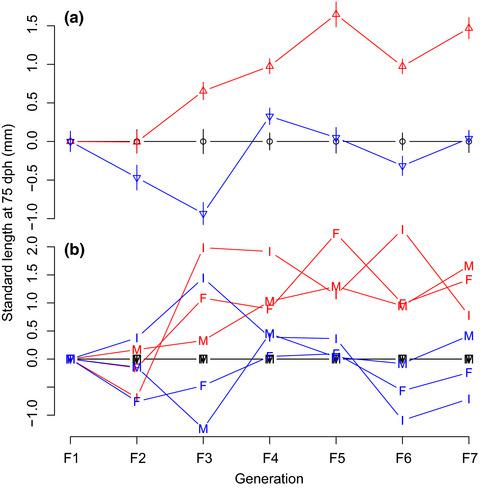当前位置:
X-MOL 学术
›
Ecol. Evol.
›
论文详情
Our official English website, www.x-mol.net, welcomes your
feedback! (Note: you will need to create a separate account there.)
Unidirectional response to bidirectional selection on body size. I. Phenotypic, life‐history, and endocrine responses
Ecology and Evolution ( IF 2.3 ) Pub Date : 2020-09-13 , DOI: 10.1002/ece3.6713 Clémentine Renneville 1 , Alexis Millot 2 , Simon Agostini 2 , David Carmignac 1 , Gersende Maugars 3, 4 , Sylvie Dufour 3 , Arnaud Le Rouzic 5 , Eric Edeline 1, 6
Ecology and Evolution ( IF 2.3 ) Pub Date : 2020-09-13 , DOI: 10.1002/ece3.6713 Clémentine Renneville 1 , Alexis Millot 2 , Simon Agostini 2 , David Carmignac 1 , Gersende Maugars 3, 4 , Sylvie Dufour 3 , Arnaud Le Rouzic 5 , Eric Edeline 1, 6
Affiliation

|
Anthropogenic perturbations such as harvesting often select against a large body size and are predicted to induce rapid evolution toward smaller body sizes and earlier maturation. However, body‐size evolvability and, hence, adaptability to anthropogenic perturbations remain seldom evaluated in wild populations. Here, we use a laboratory experiment over 6 generations to measure the ability of wild‐caught medaka fish (Oryzias latipes) to evolve in response to bidirectional size‐dependent selection mimicking opposite harvest regimes. Specifically, we imposed selection against a small body size (Large line), against a large body size (Small line) or random selection (Control line), and measured correlated responses across multiple phenotypic, life‐history, and endocrine traits. As expected, the Large line evolved faster somatic growth and delayed maturation, but also evolved smaller body sizes at hatch, with no change in average levels of pituitary gene expressions of luteinizing, follicle‐stimulating, or growth hormones (GH). In contrast, the Small medaka line was unable to evolve smaller body sizes or earlier maturation, but evolved smaller body sizes at hatch and showed marginally significant signs of increased reproductive investment, including larger egg sizes and elevated pituitary GH production. Natural selection on medaka body size was too weak to significantly hinder the effect of artificial selection, indicating that the asymmetric body‐size response to size‐dependent selection reflected an asymmetry in body‐size evolvability. Our results show that trait evolvability may be contingent upon the direction of selection and that a detailed knowledge of trait evolutionary potential is needed to forecast population response to anthropogenic change.
中文翻译:

对身体尺寸双向选择的单向响应。 I. 表型、生活史和内分泌反应
诸如收获之类的人为干扰通常会选择不利于大体型的行为,并预计会诱导向更小体型和更早成熟的快速进化。然而,野生种群的体型进化以及对人为扰动的适应性仍然很少被评估。在这里,我们使用超过 6 代的实验室实验来测量野生捕获的青鳉鱼 ( Oryzias latipes ) 响应模仿相反收获制度的双向大小依赖选择而进化的能力。具体来说,我们对小体型(大系)、大体型(小系)或随机选择(对照系)进行选择,并测量多个表型、生活史和内分泌性状的相关反应。正如预期的那样,大型品系进化出了更快的体细胞生长和延迟的成熟,但在孵化时也进化出了更小的体型,而黄体生成素、卵泡刺激素或生长激素 (GH) 的垂体基因表达的平均水平没有变化。相比之下,小青鳉品系无法进化出更小的体型或更早的成熟,但在孵化时进化出更小的体型,并显示出略微显着的增加生殖投资的迹象,包括更大的卵尺寸和更高的垂体 GH 产量。自然选择对青鳉体型的影响太弱,不足以显着阻碍人工选择的效果,这表明体型对体型依赖选择的不对称反应反映了体型进化的不对称性。我们的结果表明,性状的进化可能取决于选择的方向,并且需要对性状进化潜力的详细了解来预测种群对人为变化的反应。
更新日期:2020-10-12
中文翻译:

对身体尺寸双向选择的单向响应。 I. 表型、生活史和内分泌反应
诸如收获之类的人为干扰通常会选择不利于大体型的行为,并预计会诱导向更小体型和更早成熟的快速进化。然而,野生种群的体型进化以及对人为扰动的适应性仍然很少被评估。在这里,我们使用超过 6 代的实验室实验来测量野生捕获的青鳉鱼 ( Oryzias latipes ) 响应模仿相反收获制度的双向大小依赖选择而进化的能力。具体来说,我们对小体型(大系)、大体型(小系)或随机选择(对照系)进行选择,并测量多个表型、生活史和内分泌性状的相关反应。正如预期的那样,大型品系进化出了更快的体细胞生长和延迟的成熟,但在孵化时也进化出了更小的体型,而黄体生成素、卵泡刺激素或生长激素 (GH) 的垂体基因表达的平均水平没有变化。相比之下,小青鳉品系无法进化出更小的体型或更早的成熟,但在孵化时进化出更小的体型,并显示出略微显着的增加生殖投资的迹象,包括更大的卵尺寸和更高的垂体 GH 产量。自然选择对青鳉体型的影响太弱,不足以显着阻碍人工选择的效果,这表明体型对体型依赖选择的不对称反应反映了体型进化的不对称性。我们的结果表明,性状的进化可能取决于选择的方向,并且需要对性状进化潜力的详细了解来预测种群对人为变化的反应。











































 京公网安备 11010802027423号
京公网安备 11010802027423号